Inside: These are, in our opinion, the 17 best educational board games for kids. We own each game on the list and play them all on a regular basis. Learn basic game rules, the educational focuses of each game, and things to be aware of before purchasing.
If you don’t play educational board games in your homeschool, I only have one question for you.
Why the heck NOT?!
Board games are one of the easiest (and funnest) ways to fit in learning naturally. You get to connect with your kids, learn, have fun. What’s not to love?!
(Unless of course you hate board games, in which case pick the quick game options on the list. Maybe you’ll learn to love them?)
Why learn something the boring way when you can learn it the fun way?
We play games 2-3 times a week in our homeschool. I consider them an essential part of our homeschool week because there is just so much learning jam packed into each and every game, no matter which one you choose.
Related: 30+ Best Science Board Games for Kids
Building an Educational Board Game Collection Takes Time (& yes, $$$)
THIS POST PROBABLY CONTAINS AFFILIATE LINKS. AS AN AMAZON ASSOCIATE, I EARN FROM QUALIFYING PURCHASES. YOU CAN READ OUR FULL DISCLOSURE POLICY HERE.
Certain board games can be expensive, I know.
Forty or fifty bucks for a game you aren’t even sure you’re going to like and play regularly? It can feel like a big risk depending on your budget.
But for our family, investing in board games is a priority. We spend FAR more on educational board games, experiences (like museums) and interest-led learning than we do on curriculum.
To save money on building a board game collection, look at thrift stores – they’re a gold mine – and eBay is another great source.
Card and dice games (yep, I cheated and called them all board games, you caught me) are often cheaper, less than $20 new.
Use the Honey extension on your browser to see how low the price goes on Amazon and wait for that price (or add to your cart and get price updates when it goes lower).
Add games to your Christmas wish list.
See if you can “try out” games via awesome homeschool friends before you buy them.
Ultimately, it’s a risk, which is why I hope to mitigate some of that risk by telling you what OUR favorite educational board games are (we own upwards of 40 games).
We own and love every single educational board game on this list, and the majority of them are under $20!
Not every game on this list will probably end up being your favorite, but again, start with the cheaper ones to work your way up to those bigger game purchases.
(P.S. In case you’re wondering why Money Bags is pictured when it’s not listed here, it got cut at the last minute because we don’t play it now that the kids are older. But it was a favorite when my kids were small!)
Related: 20+ Best Math Board Games for Kids
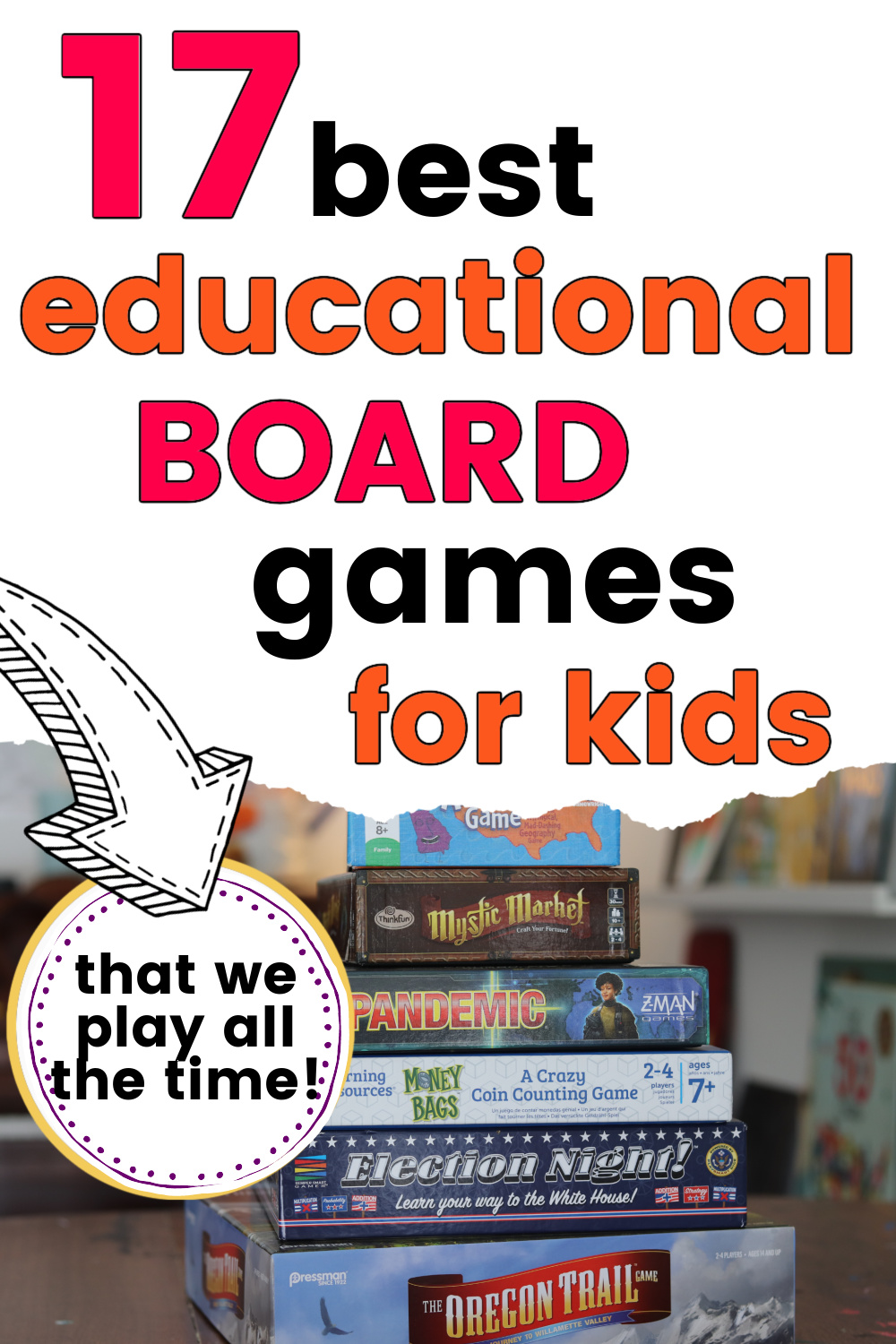
Best Educational Board Games for Kids
Many of these board games do require reading skills, but there are a few that can be played without knowing how to read.
Those particular games are noted in the description.
For reference, we play these regularly with an 11, 9, and 7-year-old.
You Might Also Like: 20+ Best Games for Family Game Night (According to Parents)
1. Ticket to Ride

This is by far one of our favorite educational board games!
We own both the original version and the Europe version. Both are fun, but the Europe version is a bit more complicated. Definitely start with the original!
Ticket to Ride is a great way to practice/learn reading skills, addition, strategy, and central North American geography (most of the cities are in the United States, with a few in southern Canada).
At the beginning of the game, each player chooses three route cards to start. Each route card lists two specific cities you need to connect with your tracks, and each route is worth different amounts depending on how far apart the cities are.
You can choose to keep all three routes, but you must keep at least two. If you complete your routes, you can use a turn to pick up more routes later in the game.
The game continues with each player choosing only one of three actions each turn:
- Build a track (must have the required number of cards)
- Pick up new train cards
- Pick up new route cards
Game play takes around 60 minutes, and you can play with 2-5 players. The player with the most points at the end of the game (complete routes + points from tracks + longest route) wins.
Purchase Ticket to Ride on Amazon HERE.
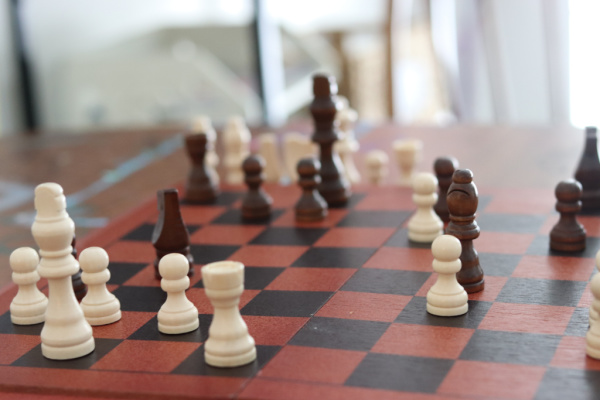
2. Chess

If you don’t have a Chess set in your educational board game collection, get a copy right now!
There’s nothing like this classic game to teach logic and strategy, thinking ahead through multiple different play options in your head, and consistently dealing with new, unanticipated problems.
If you’re unfamiliar with Chess, each piece is allowed different moves, whether it be the Bishop, which can only be moved diagonally, or the Queen who is free to move in any single direction.
The ultimate goal is to “trap” your opponent’s King in checkmate, blocking off any means of escape.
If your child develops a strong interest in chess, you can always purchase a strategy book like THIS one that teaches various play combinations used by professional chess players.
Children as young as 4-years-old can learn to play Chess.
This two-player game can take anywhere from 20 minutes to 2 hours to play, depending on the skill level of the players.
Purchase Chess on Amazon HERE.
3. Scrambled States

All of the board games on this list are favorites, but we play Scrambled States frequently because it’s quick and easy to play. If you have toddlers in your homeschool, having a stash of quick and easy games in your collection is a MUST.
Learn and practice United States geography (each player gets their own United States map). Brush up on state capitols and state nicknames. The game also builds in language arts with references to vowels, consonants and syllables on the play cards.
Each player is dealt five state cards at the start of the game, with a stack of “play cards” sitting in the center of the table. As each card is flipped, you check to see if you have any state cards in your hand that match what is stated on the card.
For example, the card might say “Has 3 Vowels in the State Capitol.” If you have a state whose capitol has three vowels, you get to put that state in your “win” pile. If you have multiple cards that match the play card description, you can only choose one to put in your “win” pile.
When the play card pile is used up, the game ends, and the player with the most states in their “win” pile wins!
Purchase Scrambled States on Amazon HERE.
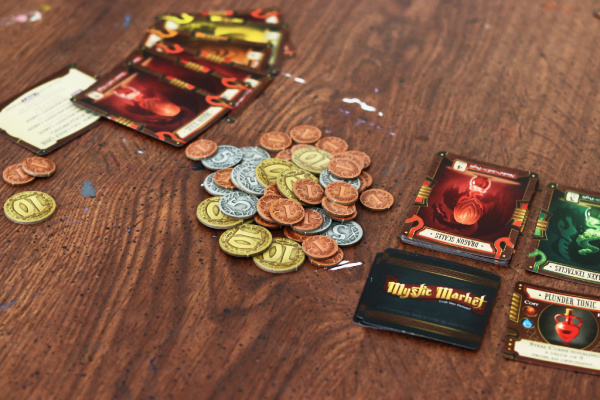
4. Mystic Market
I’m pretty sure I love this game more than my kids, but that’s o.k.
Mystic Market develops reading skills (as almost all games do), learning very low level economics as the potion ingredients constantly shift in value, and balance different strategies for earning the most money by the time the ingredient deck runs out.
Players start the game with a handful of potion ingredient cards. Potion vials sit on a sloped rack, and their position indicates how much they are currently worth.
Each potion ingredient requires a certain number of the same cards in order to sell. Determining when to sell is key as the values are constantly shifting based on supply shift cards and when someone else sells a potion ingredient.
When an ingredient is sold, that ingredient’s value automatically shifts to the lowest spot on the rack (therefore increasing the value of every other ingredient).
On each turn, players can craft as many potions as they want and do only one of the following:
- Buy 1 or 2 ingredient cards from the “market” (ingredient cards are shown face up) or the deck
- Swap 1 or 2 ingredient cards from the market only
- Sell ingredient cards
When the ingredient deck runs out, each player gets one last turn, and whoever has the most money wins.
You can find Mystic Market on Amazon HERE. Sadly, it’s no longer sold, but you can find it on eBay.
5. Settlers of Catan

Primarily a strategy/logic board game with a dose of math via dice roll probability, Settlers of Catan is designed for ages 10 and up, but my 7-year-old plays with us and wins half the time, sooo…
The original version allows for up to four players, but the expansion pack that we have increases the number of players to six. This game takes about two hours to play.
Catan is a world filled with hexagonal tiles, which represent five individual resources: grain, wood, brick, ore, and sheep. These resources – in various combinations allow you to build things and buy development cards.
Each resource has a number tile in the center; those tiles are marked with dots indicating higher probability numbers (e.g. 6 & 8 have three dots because besides a 7, they are most likely numbers to be rolled). When the dice is rolled, any players with settlements or cities on the corresponding resource gets to collect that particular resource.
If you happen to choose resources whose numbers are rarely rolled, you have a difficult time progressing in the game because you will have no resources to work with.
The aim of this board game is to reach ten points first.
You gain points through any combination of settlements, cities, roads and development cards. Longest road and biggest army offer additional bonus points.
You can find Settlers of Cataan on Amazon HERE.
6. Ecosystem

Update: This game seems to be (hopefully temporarily) unavailable at the moment. Ecologies was created by a science teacher and is a similar card game with the same themes. And it’s even better for learning about ecosystems!
This game was gifted to us by Board Game Geek, and it quickly became a family favorite.
It lightly touches on ecosystem basics, math skills for scoring at the end, and like most games requires developing a unique strategy in order to win.
Ecosystem is quick and easy to play once you learn the rules. We usually finish games in around twenty minutes.
The game’s creator states the target ages as 14 and up, but we easily play with kids as young as 7.
You don’t necessarily need to be able to read to play, as someone else can score your hand for you. You do need a verbal explanation and solid understanding of the scoring rules behind each card.
The goal of the game is to build an Ecosystem in an ecosystem, which consists of a 4×5 grid of cards.
Players play from their hand, and then pass their hands to the left for the first ten rounds of play. They then receive a new set of ten cards and pass their hands to the right.
Scoring is based on how diverse your ecosystem is, and where you chose to place your cards (next to certain ones, farther away from others, etc.). The player with the most points wins.
Purchase Ecosystem on Amazon HERE.
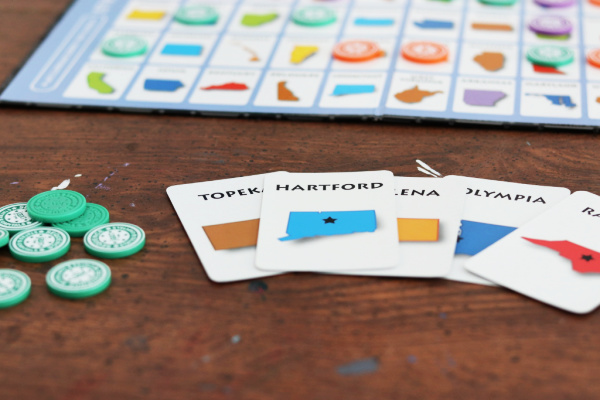
7. Sequence: States & Capitols

Another geography board game, Sequence States & Capitols is the only version of Sequence we have.
I figured, if there’s an educational version, why not buy that one?
The game rules are the same as regular sequence, but the board is populated with states, and the cards in your hand are the matching capitols. The cards have the state picture, so you could play even with children who can’t read yet.
The point of the game is to get 1 (or 2) “five in a row’s”. 2-12 players can play. If you choose more than two players, you need an even number of players in order to play on equal teams.
Unfortunately, Sequence States & Capitols seems to be out of stock at a lot of major retailers. You can check this Walmart listing to see if it comes back into stock, see if it’s available on eBay, OR there are a few sellers on Amazon HERE.
I hope this comes back into production soon because it’s a great educational board game!
8. Boggle

Another older classic game, Boggle is a great way to work on spelling, vocabulary and word familiarity. At the end of each round, I make sure to point out each of my words to younger players who I know are working on spelling.
A timer is included, or you can use your own timer.
Boggle is set up as a 4×4 grid of letter cubes. Each letter cube has 6 different letters total, one on each side. A lid is included so the letter cubes can be shaken and reconfigured each round of play.
The goal of the game is to find as many words as possible, in any arrangement possible (straight, diagonal, etc.) in the time allotted. The letters do need to touch in order – corner to corner or side to side – for the word to count.
I know there are formal rules for this game. The words you find are scored according to length, with longer words earning more points. Players cross off words that other players also found, scoring only their unique finds.
However, I’ve found that this game is much better played informally.
If you need another non-competitive, board probably won’t be flipped, kind of game to add to your game rotation, this one can fit the bill with some modifications.
We still cross off words found by other players. We simply tally the number of words found each round and declare a “winner” per round.
If older players set the tone as a fun and non-competitive game, younger players will feel comfortable participating, even if they only find 2-3 words each round.
Purchase Boggle on Amazon HERE.
9. Election Night

This one was an obvious purchase last year with the 2020 election happening. We really enjoyed this game…but with a caveat that I’ll get to.
Election Night helps kids (and adults) understand the complicated American Electoral College system, learn U.S. Geography and practice math facts – addition and multiplication – at the same time.
The dry-erase gameboard contains a United States map with all 50 states. Along the sides are groups of states assigned to a number.
Each state has a shape, and depending on how many electoral votes that state contains, the shape is divided into wedges. The more electoral votes, the more “wedges” in that state’s shape, so it is more difficult to win states with more electoral votes.
Players divide into two teams, one side is the Republicans, and the other is Democrat.
For the addition side of the same, on each turn, four 12-sided dice are rolled simultaneously. Players make two different combinations with the dice (e.g. 8+9 & 7+5; OR 8+7 & 9+5), and then choose which combination they want to go with.
The combination they choose determines which group of states they can choose a state from to “put a stake in”.
If the state has only a single circle, they take the state and win all of that states electoral votes. If the state has multiple wedges, they can color in one wedge (a.k.a. put a stake in). Once they has the majority of wedges in a state, they win that state’s electoral votes.
The goal of the game is naturally to get 270 electoral votes or more, first.
You can play the addition side or the multiplication side (uses 2 different 12-sided dice). Unfortunately the multiplication side was too complicated for us to enjoy playing the game. I really wanted it to work because theoretically, it would have been a great way to practice multiplication tables, but the system was too complex for my kids (ages 7-11).
The game’s suggested ages are 8 and up, and game play takes around 60 minutes.
Purchase Election Night on Amazon HERE.
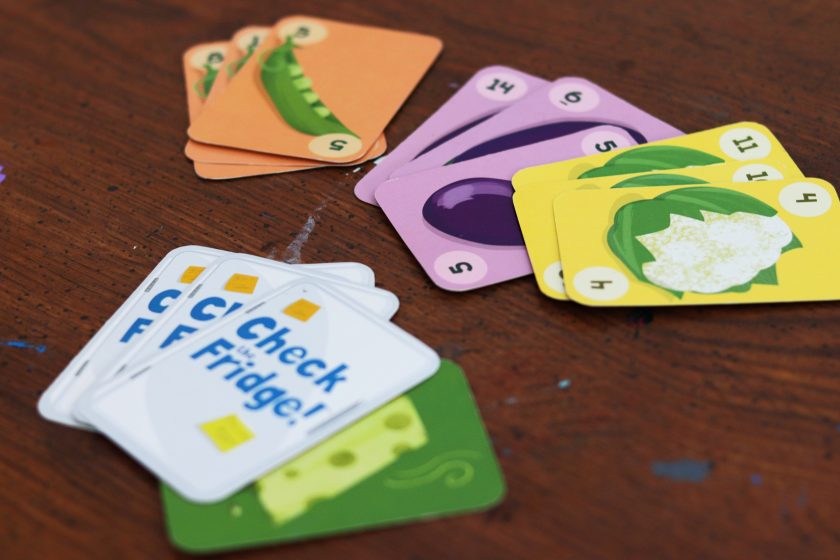
10. Check the Fridge

This fast-paced card math game help solidify addition facts, specifically combinations of 3 numbers that adds up to 25.
Each player is dealt five cards to start. These cards are one of six card types:
- eggplant
- cauliflower
- carrots
- peas
- radishes
- stinky cheese
Every card except the stinky cheese (which counts against your final score if you get stuck with it) also has a number, and every vegetable type has a predictable set of three numbers.
So for example, eggplant cards can only have three numbers: 6, 14, and 5. Together, they are a “set” and equal 25.
Stinky cheese cards count against you, and you want to get rid of them if you can. And you especially don’t want other people to know that you have a stinky cheese card.
The player with the highest score wins.
Purchase Check the Fridge on Amazon HERE.
11. Oregon Trail

I won’t lie to you: this one caused some tears the other day. We still love it…but yes, tears.
In short, the age recommendation (13 and up) means what it says. We choose to play with younger players, but it’s a complex and mentally challenging game.
And historically speaking, not everyone made it to Willamette Valley…so if you have a sensitive kiddo in your homeschool – one who agonizes over everybody in the wagon needing to make it (and not die) – this is not the game for you.
If I had to choose one educational focus for this board game besides U.S. history, it would be decision-making.
Players will be repeatedly forced to choose from two not so amazing outcomes (e.g. lose health points on a winter store tile with no winter clothes or risk not getting a gun and starve).
All players start out at Independence with a driver and four wagon members each at “5” health. Each player also starts with two trail tiles and $200.
Each turn, players do the following:
- choose a Calamity card (can good things or have bad things happen)
- play trail tiles
- take 3 actions, and try to resolve your calamity
- feed your family (if you can’t, they lose one health point each)
As you follow the trail, you face river crossings, needing to buy supplies, hunting itself and picking up hitchhikers. When family members die, you “bury them” on the side of the trail, and the closer you are to Willamette Valley when they die, the less you have to deduct for their loss at the end of the game.
The goal of the game is, of course, to make it Willamette Valley with the most money leftover. The more people you keep alive and the more supplies you have at the end of the game, the more likely you are to win.
(We will likely try the card game in the future to see if it’s a bit less complex. I will be sure to update the post when we do!)
Purchase Oregon Trail on Amazon HERE.
12. Pay Day

Oh Pay Day, teaching the realities of good old life, where the mail mostly contains bills (sad, but true), and you need to fork over a ton of money for groceries.
Sounds pretty realistic to me.
The board is a calendar, and most days, something happens when you land on it – you get bills in the mail, surprise birthday money, an investment opportunity, or the lottery to play (or not to play), etc.
Like Monopoly (decidedly NOT one of our favorite games), players start out with a set amount of money at the beginning of the month.
The beauty of this game is that you get to decide in advance how many months to play. You can play as many months as you want really, from one up. (We usually choose to play two months.)
Everyone plays to the end of the month, when bills get paid (and hopefully loans paid back). Then everyone starts the next month together.
The player with the most money at the end of the game wins.
Purchase Pay Day on Amazon HERE.
13. Clue

The classic game of logic and deduction, Clue is a must-have for any family – homeschool or not.
Players learn how to deduce which cards are in the secret envelope through a process of elimination, and paying close attention to the questions their opponents are asking along the way.
Before the game begins, the cards are separated into three piles:
- rooms
- players
- weapons
With each pile facing down, someone selects a card from each pile and places the three cards in the secret envelope. The remaining cards are dealt evenly to the players. Each player has a paper to mark off the various elements – people, weapons and rooms – that they know are NOT in the envelope.
Players roll the dice and make their way to various rooms, where they make an accusation: “Miss Scarlett, with the wrench, in the Ballroom.”
The player to their left offers the accuser proof that this accusation is false by revealing one of the cards stated in the accusation.
When a player thinks he/she knows which three cards, he states the three cards he believes to be in the secret envelope and checks to see if he is correct.
If the player is wrong, he is out of the game, and the remaining players continue game play. If he is right, he wins.
The version we have speeds up game play using Clue cards and a special die.
Purchase the classic version of Clue on Amazon HERE.
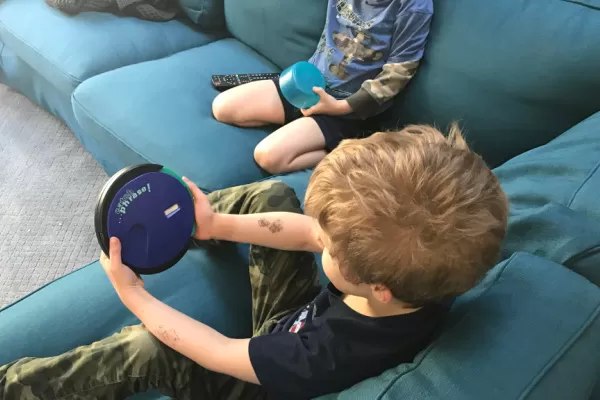
14. Catch Phrase

This is another game we choose not play traditionally. In fact, we often just use the disc-changer and play informally, not counting the score.
Catch Phrase is a great game for building vocabulary, developing fast word recall and verbal skills and learning common cultural knowledge and idioms.
In our informal version, we usually play as one team. We all take turns giving the clues while the rest of us guess. The continues until the clue-giver gets tired…or someone else begs for a turn.
If you’re playing classic rules, players divide into two teams, and one team plays at a time.
Each team rotates between one player who gives clues about the word on the card (our ancient card version is a thing of the past now, apparently – it’s all electronic), and the rest of the team guesses the word. There’s usually a one minute (two minutes?) timer and a board or paper to keep score.
The team with the most points wins.
Purchase the updated version of Catch Phrase on Amazon HERE.
15. Yahtzee

Another classic dice game, we love Yahtzee for working on math skills. There is also some calculated strategy and decision-making involved when choosing whether or not to try for a certain dice combination.
Each player gets a scoring sheet with blank spots for each dice combination, including (but not limited to) poker-related hands like a full house, large straight and small straight. A Yahtzee is five of a kind.
On each turn, players roll five dice simultaneously. They can choose to keep all five dice as is or reroll anywhere from one to all five dice again.
After three rolls, the player needs to decide which spot to “fit” the dice into.
For example, if there are three two’s, a player could use the “2’s” spot OR the “three of a kind” spot. If there are no available spots left where the roll can fit, the player is forced to choose where to put a “0”.
Play continues until all players have filled every blank. Players score according to the card directions, and the player with the highest score wins.
Purchase Yahtzee on Amazon HERE.
16. Quixx

A new addition to our educational board game collection, Quixx quickly became a family favorite.
The game includes Quixx scoring sheets (each player gets one per game) and six dice (2 white, 1 red, 1 blue, 1 green, 1 yellow).
The main skill required in this game is strategy, deciding which number(s) to cross off on your scoring sheet, and in which color, to give you the best chance of getting the most “X’s”.
You need to chose carefully because once you cross off a number, you can no longer cross off numbers to the left of your furthest right “X” in that color row. That also means you can no longer earn points from those numbers.
The game ends when any one player marks off their third “penalty” box. Players cross off a penalty box when they have no legitimate play based on the dice rolled.
Each player’s score sheet tells you how to score, making it easy for players to score their own sheet. The more X’s you get, the more your score exponentially increases. Each penalty box counts negatively towards the overall score.
The player with the highest score wins.
Purchase Quixx on Amazon HERE.
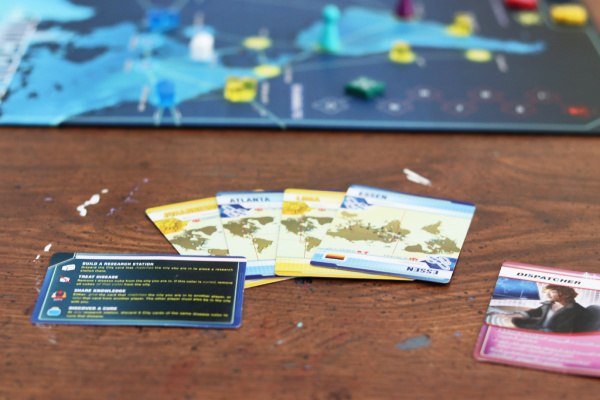
17. Pandemic

We bought this game to pass the time during lockdown in March 2020. It seemed like a fitting educational board game purchase for last year.
This game focuses on world geography, science and cooperation.
A cooperative game, Pandemic requires players to work together to eradicate four different viruses before the epidemic beats you.
Each player is assigned a role, with each role having special abilities that when used properly, make beating the virus easier. While a player can do what he wants during a turn, the game works better when everyone discusses the best options per turn, keeping in mind the special role abilities of that turn’s player.
Each turn, players choose new city cards. They are allotted four moves, in which they can move to a city, remove a virus cube, build a research center, exchange cards or cure a disease.
At the end of each turn, city cards are chosen from a deck, and virus cubes are added to those cities based on the current infection rate. Players collect colored city cards in hopes of curing one of the four diseases, while simultaneously stopping the spread with various strategies.
If an epidemic card is drawn from the deck (instead of a city card), the spread of the virus speeds up, along with the infection rate. You’re in a race against the deck.
The game can be modified for difficulty by choosing how many epidemic cards go into the city deck at the start of the game.
If you “cure” a disease, those virus cubes can no longer be added to the game. Cure all four before the pandemic reaches a “7”, and you win.
Purchase Pandemic on Amazon HERE.
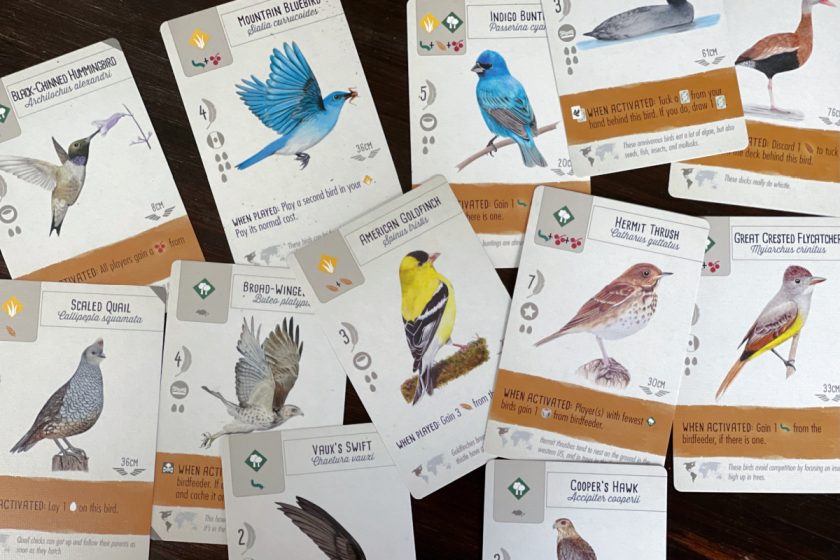
18. Wingspan
We purchased Wingspan for Christmas last year, and it’s become my personal favorite!
It is a fairly intricate game with layers of strategy to it. My 8-year-old can play it with support, but keep the age limits (14+) in mind.
Let’s start with the absolutely beautiful bird cards. There are 170 unique cards, which include where the bird lives and a fun fact about each bird.
You can also download the Wingsong app and play each unique bird call (our favorite part).
Players build up their bird sanctuary by carefully playing cards in each type of habitat. Each habitat corresponds to a unique action:
- Getting Food
- Laying Eggs
- Getting Cards
You need birds in each type of habitat to progress in the game. The more birds you have in each habitat, the more effective each turn will be (e.g. if you have 4 bird cards in the forest, your “get food” turn will yield more food than if you only have one).
There are so many different features to the game that earn you more points, but you’ll just have to see for yourself! If you love board games, I don’t know how you won’t love this one.
Purchase Wingspan on Amazon HERE.
19. Organ Attack
A new to us favorite, this game is fantastic for learning about the human body and various diseases and conditions!
It is definitely a ruthless game, the object being to eliminate all the other players, but there is so much learning here. Even my kids who aren’t typically interest in the human body read each and every card.
You can find it on Amazon HERE.

What Makes a Board Game “Educational” Anyway?
I hoped you’d ask. And the answer is…
Not much.
There, I said it: all games have educational value.
I mean, if you want to look at these games primarily through the lens of “school”, these particular ones are “educational” because they develop and practice skills that schools highly value.
Math. Spelling. Logic. Reading.
But most games do this (including the evil video games).
What about other just as valuable skills? Like compassion and empathy and reading people.
For example, in Check the Fridge? Players practice reading people’s faces, trying to find out who’s hiding the Stinky Cheese.
But it’s rarely the skill people talk about when they praise Check the Fridge – they talk about the MATH. Duh.
Because somehow math is more valuable than learning to read people?
If we are literally ALWAYS learning, then it’s time to stop separating out educational activities from non-educational activities.
We need to stop putting skills on a scale of most valuable to least valuable, and see ALL learning as valuable. We need to stop segmenting educational activities from non-educational activities in our minds.
Really, truly ALL games are educational. Just like all movies are educational, and all activities are educational.
Life is learning.
So enjoy ANY old board game in your homeschool – your kids are learning from it. Trust me.
Do you have favorite educational board games that aren’t listed here? Tell us in the comments!
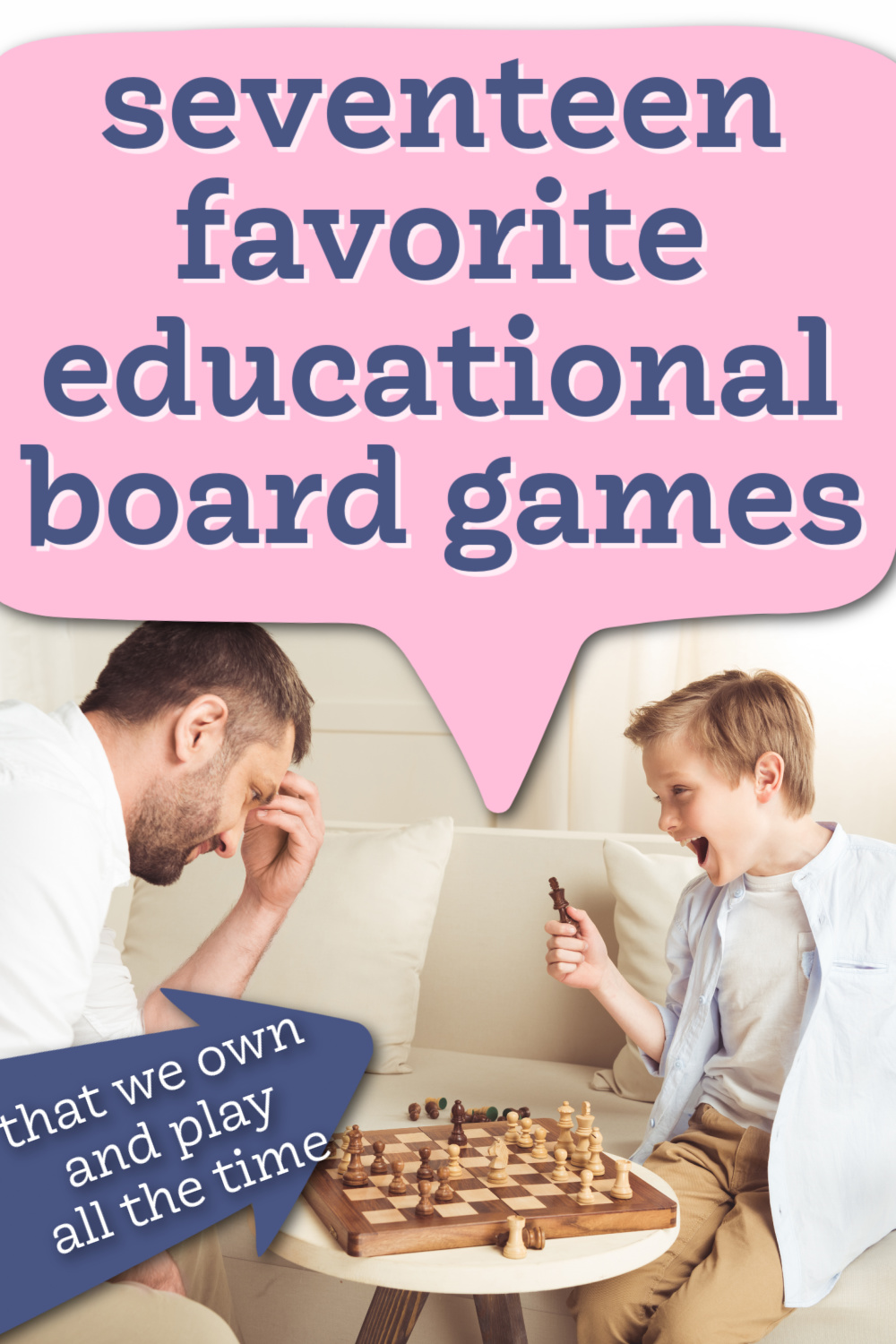

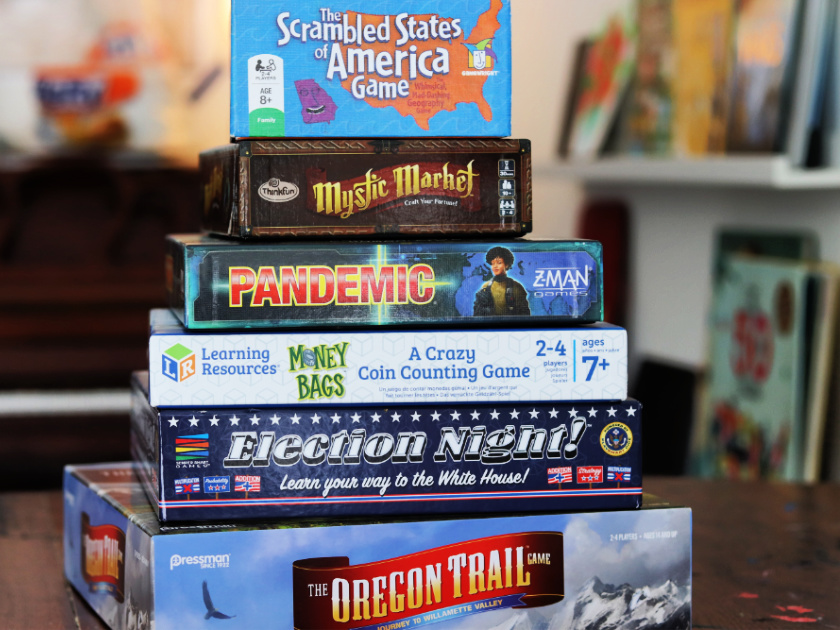
Some of our favorites:
Raccoon Tycoon
Deduckto
SushiGo
Amen!! We learn so much from games all the time. You named some of our favorites already. The ones that get played the most here are Picwits (like Apples to Apples but using pictures so no reading required), Quirkle, Sleeping Queens, Forbidden Island, and we recently got a Minecraft board game that is *incredibly* complicated but somehow my kids don’t mind 😂
I came into adulthood with board game wounds, but I vowed to make games fun for my kids, and in the process I’ve come to love them myself!